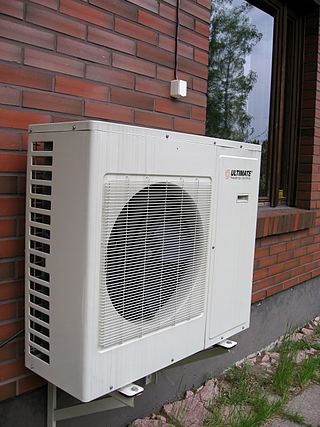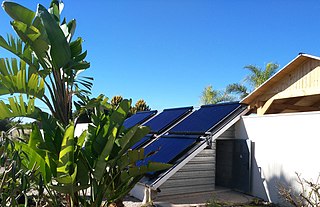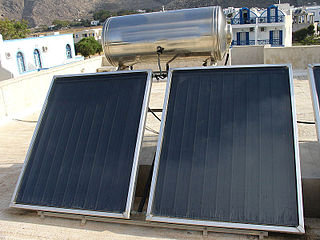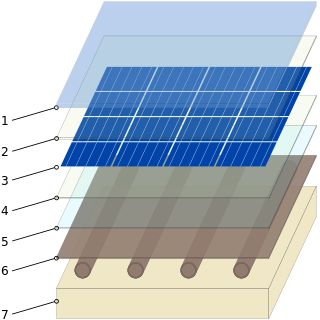An autonomous building is a building designed to be operated independently from infrastructural support services such as the electric power grid, gas grid, municipal water systems, sewage treatment systems, storm drains, communication services, and in some cases, public roads.

In passive solar building design, windows, walls, and floors are made to collect, store, reflect, and distribute solar energy, in the form of heat in the winter and reject solar heat in the summer. This is called passive solar design because, unlike active solar heating systems, it does not involve the use of mechanical and electrical devices.

A heat pump is a device that uses work to transfer heat from a cool space to a warm space by transferring thermal energy using a refrigeration cycle, cooling the cool space and warming the warm space. In cold weather a heat pump can move heat from the cool outdoors to warm a house; the pump may also be designed to move heat from the house to the warmer outdoors in warm weather. As they transfer heat rather than generating heat, they are more energy-efficient than other ways of heating a home.

Solar thermal energy (STE) is a form of energy and a technology for harnessing solar energy to generate thermal energy for use in industry, and in the residential and commercial sectors.

Water heating is a heat transfer process that uses an energy source to heat water above its initial temperature. Typical domestic uses of hot water include cooking, cleaning, bathing, and space heating. In industry, hot water and water heated to steam have many uses.

Solar water heating (SWH) is heating water by sunlight, using a solar thermal collector. A variety of configurations are available at varying cost to provide solutions in different climates and latitudes. SWHs are widely used for residential and some industrial applications.

A solar thermal collector collects heat by absorbing sunlight. The term "solar collector" commonly refers to a device for solar hot water heating, but may refer to large power generating installations such as solar parabolic troughs and solar towers or non water heating devices such as solar cooker, solar air heaters.

The Simms Building is historic high-rise office building in downtown Albuquerque, New Mexico. Designed by Flatow and Moore and completed in 1954, it was the city's first large-scale modernist building and is regarded as "Albuquerque’s best example of the International Style". The building was added to the New Mexico State Register of Cultural Properties in 1997 and the National Register of Historic Places in 1998, only 44 years after it was completed.

Thermal energy storage (TES) is achieved with widely different technologies. Depending on the specific technology, it allows excess thermal energy to be stored and used hours, days, months later, at scales ranging from the individual process, building, multiuser-building, district, town, or region. Usage examples are the balancing of energy demand between daytime and nighttime, storing summer heat for winter heating, or winter cold for summer air conditioning. Storage media include water or ice-slush tanks, masses of native earth or bedrock accessed with heat exchangers by means of boreholes, deep aquifers contained between impermeable strata; shallow, lined pits filled with gravel and water and insulated at the top, as well as eutectic solutions and phase-change materials.

Thermosiphon is a method of passive heat exchange, based on natural convection, which circulates a fluid without the necessity of a mechanical pump. Thermosiphoning is used for circulation of liquids and volatile gases in heating and cooling applications such as heat pumps, water heaters, boilers and furnaces. Thermosiphoning also occurs across air temperature gradients such as those utilized in a wood fire chimney or solar chimney.
Renewable heat is an application of renewable energy referring to the generation of heat from renewable sources; for example, feeding radiators with water warmed by focused solar radiation rather than by a fossil fuel boiler. Renewable heat technologies include renewable biofuels, solar heating, geothermal heating, heat pumps and heat exchangers. Insulation is almost always an important factor in how renewable heating is implemented.

Underfloor heating and cooling is a form of central heating and cooling that achieves indoor climate control for thermal comfort using hydronic or electrical heating elements embedded in a floor. Heating is achieved by conduction, radiation and convection. Use of underfloor heating dates back to the Neoglacial and Neolithic periods.
Seasonal thermal energy storage (STES), also known as inter-seasonal thermal energy storage, is the storage of heat or cold for periods of up to several months. The thermal energy can be collected whenever it is available and be used whenever needed, such as in the opposing season. For example, heat from solar collectors or waste heat from air conditioning equipment can be gathered in hot months for space heating use when needed, including during winter months. Waste heat from industrial process can similarly be stored and be used much later or the natural cold of winter air can be stored for summertime air conditioning.
Solar air conditioning, or "solar-powered air conditioning", refers to any air conditioning (cooling) system that uses solar power.

An absorption heat pump (AHP) is a heat pump driven by thermal energy such as combustion of natural gas, steam solar-heated water, air or geothermal-heated water differently from compression heat pumps that are driven by mechanical energy. AHPs are more complex and require larger units compared to compression heat pumps. In particular, the lower electricity demand of such heat pumps is related to the liquid pumping only. Their applications are restricted to those cases when electricity is extremely expensive or a large amount of unutilized heat at suitable temperatures is available and when the cooling or heating output has a greater value than heat input consumed. Absorption refrigerators also work on the same principle, but are not reversible and cannot serve as a heat source.

A solar combisystem provides both solar space heating and cooling as well as hot water from a common array of solar thermal collectors, usually backed up by an auxiliary non-solar heat source.
The Drake Landing Solar Community (DLSC) is a planned community in Okotoks, Alberta, Canada, equipped with a central solar heating system and other energy efficient technologies. This heating system is the first of its kind in North America, although much larger systems have been built in northern Europe. The 52 homes in the community are heated with a solar district heating system that is charged with heat originating from solar collectors on the garage roofs and is enabled for year-round heating by underground seasonal thermal energy storage (STES).

Photovoltaic thermal collectors, typically abbreviated as PVT collectors and also known as hybrid solar collectors, photovoltaic thermal solar collectors, PV/T collectors or solar cogeneration systems, are power generation technologies that convert solar radiation into usable thermal and electrical energy. PVT collectors combine photovoltaic solar cells, which convert sunlight into electricity, with a solar thermal collector, which transfers the otherwise unused waste heat from the PV module to a heat transfer fluid. By combining electricity and heat generation within the same component, these technologies can reach a higher overall efficiency than solar photovoltaic (PV) or solar thermal (T) alone.

Solar air heating is a solar thermal technology in which the energy from the sun, insolation, is captured by an absorbing medium and used to heat air. Solar air heating is a renewable energy heating technology used to heat or condition air for buildings or process heat applications. It is typically the most cost-effective out of all the solar technologies, especially in commercial and industrial applications, and it addresses the largest usage of building energy in heating climates, which is space heating and industrial process heating.

A storage water heater, or a hot water system (HWS), is a domestic water heating appliance that uses a hot water storage tank to maximize water heating capacity and provide instantaneous delivery of hot water. Conventional storage water heaters use a variety of fuels, including natural gas, propane, fuel oil, and electricity. Less conventional water heating technologies, such as heat pump water heaters and solar water heaters, can also be categorized as storage water heaters.
















